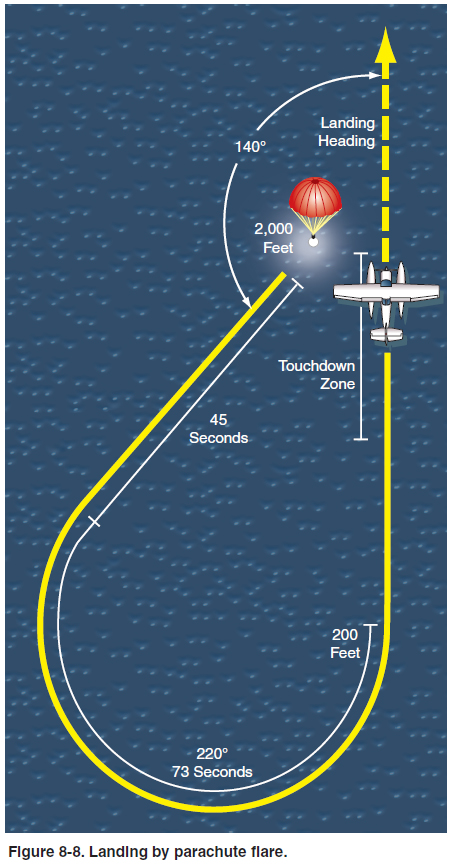| CHAPTER 8—Emergency Open Sea Operations
SEA EVALUATION AT NIGHT
Before attempting a night landing, perform a sea state
evaluation as described in previous sections. If an
emergency occurs shortly after nightfall, a landing
heading can be determined by estimating the current
conditions from those conditions prevalent before
nightfall. If the pilot has no information to form an estimate
of the conditions, the information must be
obtained from other sources or determined by the pilot
from a sea state evaluation by flare illumination or
moonlight. If near a ship, sea weather conditions and a
recommended landing heading may be obtained from
the ship. However, a landing heading based on such
information is subject to error and should only be used
as a last resort. A pilot evaluation is preferred and can
be accomplished by performing the teardrop pattern
night sea evaluation as follows:
- Set a parachute flare and adjust the altitude so
that the flare ignites at 1,700 feet. Altitude should
be as close to 2,000 feet as possible.
- After the drop, adjust altitude to 2,000 feet and
maintain the heading for 45 seconds.
- Turn back 220º, left or right, until the flare is
almost dead ahead. The sea becomes visible after
the first 70º of the turn is completed, allowing
approximately 90 seconds for sea evaluation. Use
standard rate turn (3º per second).
- Immediately after passing the flare, if it is still
burning, the pilot may circle to make additional
evaluation during remaining burning time.
If both pilot and copilot are present, the pilot should fly
the seaplane and the copilot should concentrate on the
sea evaluation. If only two flares are available and sea
conditions are known or believed to be moderate, it
may be advisable to dispense with the sea evaluation
and use both flares for landing.
accomplished, the landing approach with the use of
parachute flares is made as follows:
- Establish a heading 140º off the selected landing
heading.
- Lower the flaps and establish the desired landing
pattern approach speed.
- As close to 2,000 feet above the surface as possible,
set the parachute flare and adjust the altitude
so the flare ignites at 1,700 feet.
- Release the flare and begin a descent of 900
f.p.m. while maintaining heading for 45 seconds.
If the starting altitude is other than 2,000 feet,
determine the rate of descent by subtracting 200
feet and dividing by two. (For example, 1800
feet minus 200 is 1600, divided by 2 equals an
800 f.p.m. rate of descent).
- After 45 seconds, make a standard rate turn of 3º
per second toward the landing heading in line
with the flare. This turn is 220º and takes approximately
73 seconds.
- Roll out on the landing heading in line with the
flare at an altitude of 200 feet. During the last
two-thirds of the turn, the water is clearly visible
and the seaplane can be controlled by visual
reference.
- Land straight ahead using the light of the flare.
Do not overshoot. Overshooting the flare results
in a shadow in front of the aircraft making depth
perception very difficult. The best touchdown
point is several hundred yards short of the flare.
A rapid descent in the early stages of the approach
allows a slow rate of descent when near the water. This
should prevent flying into the water at a high rate of
descent due to faulty depth perception or altimeter setting.
[Figure 8-8]

LANDING BY MARKERS
If parachute flares are not available, use a series of
lighted markers to establish visual cues for landing.
When a landing heading has been determined and all
emergency and cockpit procedures are completed, use
drift signals or smoke floats and perform the landing
approach as follows:
- Establish a heading on the reciprocal of the landing
heading.
- Drop up to 20 markers at 2 second intervals.
- Perform a right 90º turn followed immediately
by a 270º left turn while descending to 200 feet.
- Slightly overshoot the turn to the final approach
heading to establish a path parallel and slightly
to the right of the markers.
- Establish a powered approach with a 200 f.p.m.
rate of descent and airspeed 10 percent to 20 percent
above stall speed with flaps down, as if for
a glassy water landing.
- Maintain the landing attitude until water contact,
and reduce power to idle after touchdown.
Do not use landing lights during the approach unless
considerable whitecaps are present. The landing lights
may cause a false depth perception. [Figure 8-9]

|

